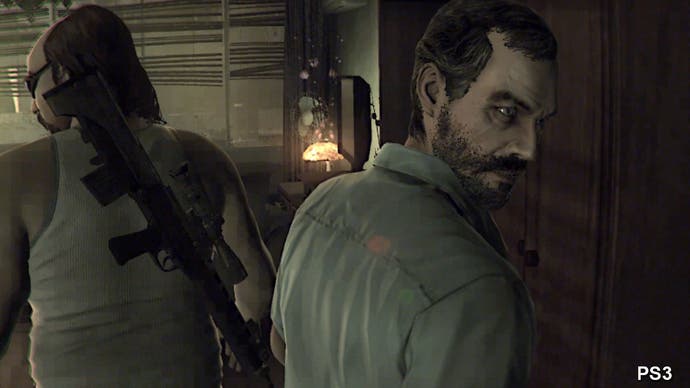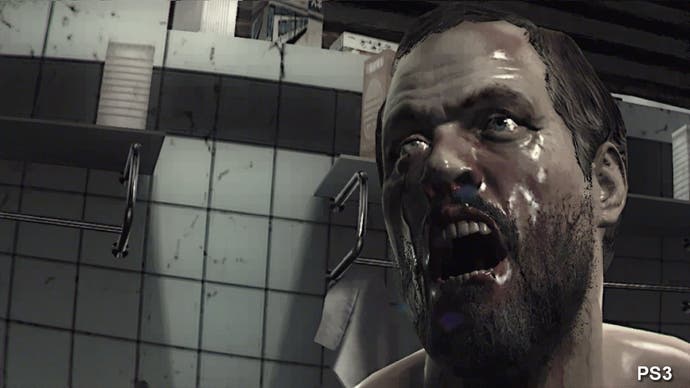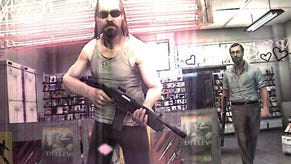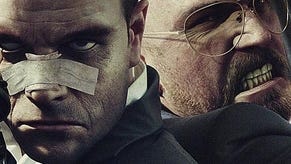Face-Off: Kane & Lynch 2: Dog Days
Xbox 360, PS3 & PC versions under the microscope.
| - | Xbox 360 | PlayStation 3 |
|---|---|---|
| Disc Size | 5.9GB | 8.26GB |
| Install | 5.9GB (optional) | 1617MB (mandatory) |
| Surround Support | Dolby Digital | Dolby Digital, 5.1LPCM, 7.1LPCM |
The seemingly never-ending summer drought in gaming is finally reaching an end. Square-Enix is first off the blocks with its high profile shooter sequel, Kane & Lynch 2: Dog Days. Released simultaneously on Xbox 360, PlayStation 3 and PC this Friday, it's the first opportunity we've had in months to produce a full-on triple-format Face-Off, and we hope to do the same with Take Two's Mafia closer to its release.
As usual, we present our unstoppable onslaught of Digital Foundry comparison assets, all derived from direct digital dumps of the HDMI and DVI ports of the respective platforms. There's also a triple-format gallery to enjoy. To begin with, here's the first of three videos designed to highlight the similarities and differences across all formats.
It's fair to say that Kane & Lynch 2 has a somewhat unique visual make-up. The framebuffer itself is undoubtedly sub-HD on both consoles - 1024x576 or slightly higher would be a good ballpark guess, but an exact, definitive measurement is difficult to ascertain (update: 1024x600 for both systems looks closer based on some fresh shots we've captured). Due to the range and number of post-processing filters in effect, the usual methods of measurement in comparing rendered pixels with native resolution seems to offer up a range of different numbers depending on the shot being analysed. What is certain is that both versions of the game operate with 2x multi-sampling anti-aliasing, and lower resolution alpha buffers are in place that add noticeable jaggies when transparencies are overlaid on characters and environments.
The big basket of different video filters the developers have available can be applied to the scene at any point. It's all about turning the basic image into the kind of "livecam" documentary feed, so we have in-game approximations of digital noise, colour separation, camera shake, macroblocking and also some ramped up contrast which serves to bleed out a lot of detail in places. There's also an effect that sees the whole scene move in and out of focus as the scene shifts.
It's an interesting idea to use an artistic approach to cover up the deficiencies in game resolution, but it comes at a price. Kane & Lynch 2 is really difficult to watch and play for extended periods: it makes my eyes water, it unsettles my stomach and for me, it induces headaches after just a couple of hours' play. A steadycam option is built into the game to cut-down on the camera shake but this is only of limited help, having no impact at all on the cut-scenes for instance. Even with steadycam engaged, I still felt quite unwell re-playing the game on other platforms for the purposes of this feature.
Mileage may well vary but if you are set on purchasing Kane & Lynch 2, I'd strongly recommend taking breaks between each level - and that's a recommendation I don't think I've ever felt compelled to make in 20 years in the games business.
So why did IO Interactive choose to go sub-HD in the first place? Kane & Lynch 2's strengths and weaknesses in terms of presentation and basic gameplay are all linked to the new graphics engine. As we discussed in our look at the demo release of the 360 code, IO Interactive has aimed for 60 frames per second gameplay. Similar to Infinity Ward's strategy for Call of Duty, the developer recognises that in a shooting game, additional temporal resolution is well worth compromises in visual quality: put simply, smoother, more responsive gameplay works better in a shooter and makes it stand out when the vast majority of your competitors are operating with twice the lag and half the frame-rate.
In terms of performance, how successful has IO been with its new engine? The 360 demo code revealed that frame-rate was variable depending on scene complexity, with plenty of tearing. A look at the final retail game is therefore in order, plus of course we can factor in performance from the PS3 version too which we've yet to cover up until now.
First up, a comparison of like-for-like action taken mostly from the engine cut-scenes. As these presumably use the same assets to generate the exact same views, it gives us a good idea of how the tech copes in a range of different scenarios.
It's clear that performance can be very variable indeed, on both platforms and on outdoor scenes in particular there seems to be something of a noticeable gulf in frame-rates between the two platforms, with the Xbox 360 version of Kane & Lynch 2 clearly running significantly more smoothly.
This represents something of a worry for the how the game will actually play, but moving the tests onwards to comparisons of performance in the same missions, we see that the PS3's deficit reduces significantly. While the Xbox 360 version of Dog Days unmistakably commands the advantage, PS3 is still a more than adequate performer.
Other than that, the differences are limited. There is a sense that there is a small resolution difference between the two platforms, but any difference is so slight that it is not really an issue. Over and above that the only other difference of note is in the implementation of screen-space ambient occlusion (SSAO), deployed on both the characters and environmental objects and giving a little extra depth to the scene.








